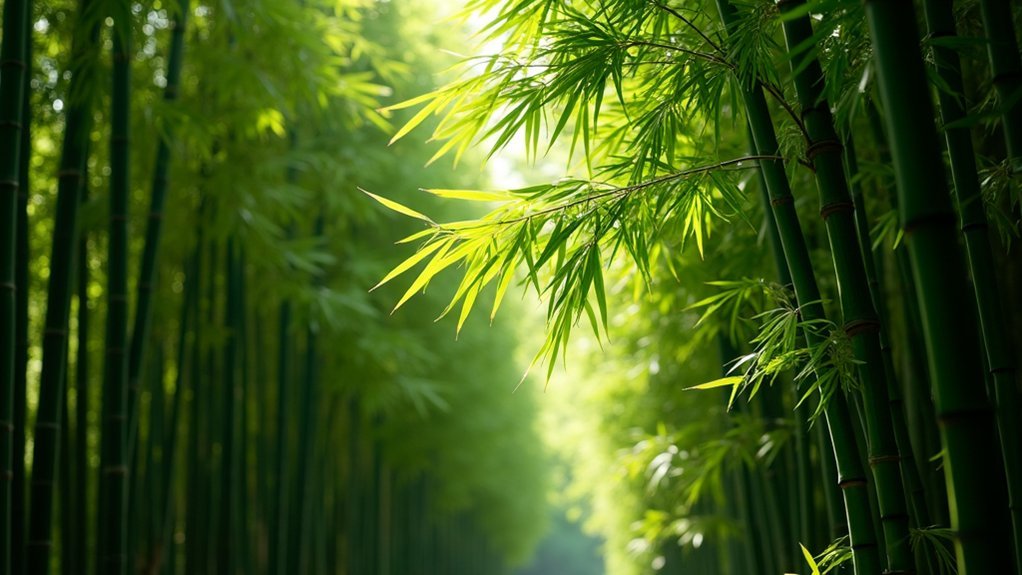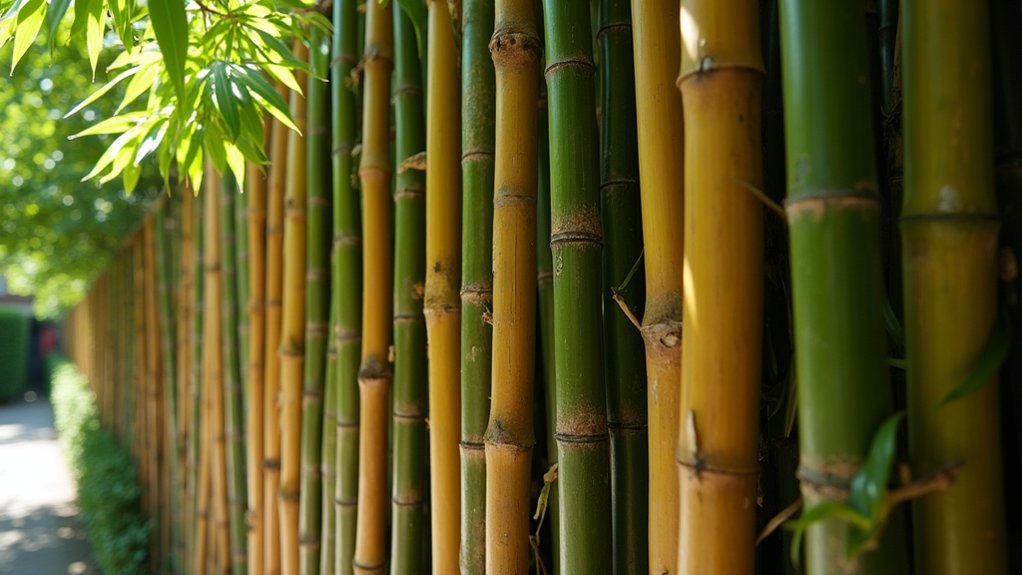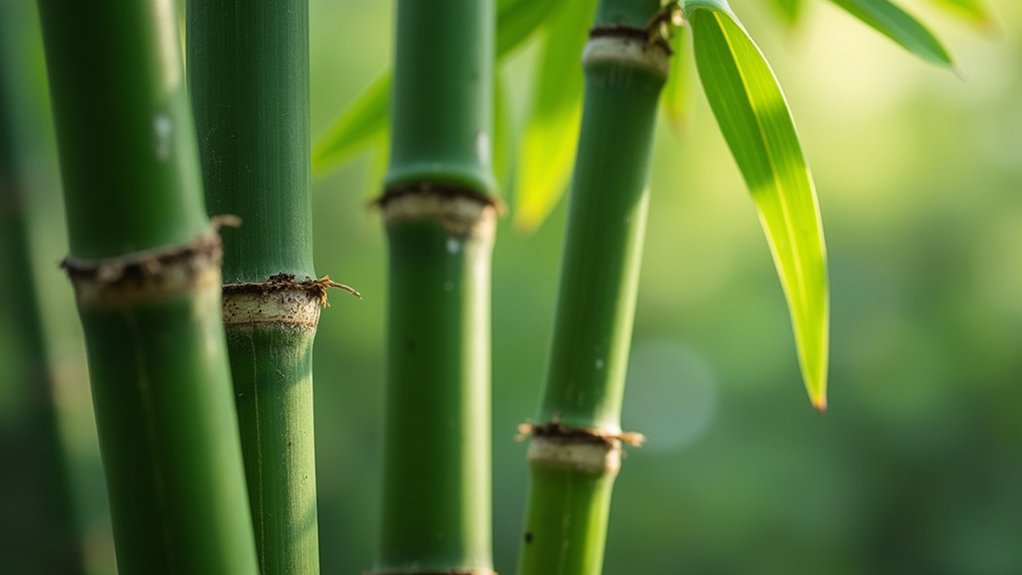For effective sound barriers, choose Dendrocalamus Minor Amoenus and Bambusa Vulgaris Wamin, which reduce noise by about 9.2 dBA. Plant these clumping bamboo varieties 1.5-2 meters apart in staggered rows to eliminate sound gaps. Maintain your bamboo with regular pruning 2-3 times yearly and proper watering to promote dense foliage that enhances sound absorption. The thick, waxy leaves are particularly effective against high-frequency sounds—just one aspect of what makes these species ideal noise reducers.
Selecting Clumping Bamboo for Maximum Noise Reduction

When creating an effective sound barrier for your property, clumping bamboo varieties offer exceptional noise reduction capabilities while maintaining an attractive appearance.
Species like Dendrocalamus Minor Amoenus and Bambusa Vulgaris Wamin provide approximately 9.2 dBA of noise reduction, particularly effective against high-frequency sounds.
These screening plants feature thick, waxy leaves that enhance their sound absorption properties, making them ideal sound-proof barriers for residential landscapes.
You’ll need less space for clumping bamboo compared to running varieties—plant them 1.5 to 2 meters apart depending on the species for best density.
For the most effective privacy screen, regular maintenance is essential.
Ideal Planting Techniques for Sound Barrier Effectiveness
To maximize your bamboo sound barrier’s effectiveness, you’ll need to implement strategic planting techniques that enhance noise absorption capabilities.
Strategic bamboo planting techniques create living sound barriers that absorb and diffuse unwanted noise effectively.
Arrange your clumping bamboo in staggered rows rather than straight lines to create denser privacy screens that block sound more efficiently.
When establishing your noise barrier, consider these key planting approaches:
- Space plants 1.5-2 meters apart to balance growth needs with sound-blocking density
- Combine Dendrocalamus Minor Amoenus with complementary plants like Viburnum for multi-layered absorption
- Plant in zigzag patterns to eliminate sound-penetrating gaps between culms
- Maintain regular trimming to control height while promoting dense foliage
Remember that ideal planting techniques for bamboo sound barriers involve both initial placement strategy and ongoing maintenance, ensuring your living wall remains an effective acoustic shield year-round.
Maintenance Strategies for Long-Term Acoustic Performance

Maintaining your bamboo sound barrier’s acoustic performance requires consistent attention long after the planting phase ends. Clumping bamboos like Dendrocalamus Minor Amoenus need strategic care to maximize their sound absorption capabilities while providing privacy.
| Maintenance Task | Frequency | Acoustic Benefit |
|---|---|---|
| Pruning | 2-3 times yearly | Maintains density for better sound blocking |
| Watering | Weekly (adjust seasonally) | Promotes fuller foliage for absorption |
| Fertilizing | Spring and summer | Enhances leaf thickness for noise reduction |
| Pest monitoring | Monthly | Prevents degradation of barrier integrity |
| Mulching | Bi-annually | Supports root health for barrier longevity |
Regular maintenance strategies protect your investment in privacy while ensuring long-term efficacy. Check bamboo regularly for pests and diseases that could compromise your sound barrier’s performance, as healthy plants provide superior acoustic benefits.
Frequently Asked Questions
What Is the Best Bamboo for Sound Barrier?
For the best sound barrier, you’ll want clumping bamboo varieties like Dendrocalamus Minor Amoenus or Bambusa Vulgaris Wamin. They’re non-invasive and can reduce noise by 9.2dBA when planted densely at 1.5-2m spacing.
Is Bamboo Good for Soundproofing?
Yes, bamboo’s good for soundproofing. You’ll get about 9.2dBA reduction over 6 meters. It’s better against high-frequency noise than low. Its dense foliage and rustling leaves help mask unwanted sounds while looking attractive.
What Is the Best Bamboo to Block Neighbors?
China Gold bamboo is your best option to block neighbors. It grows up to 10 meters tall with 4 cm stems, creating an effective sound barrier. Alphonse Karr is another great choice for dense screening.
What Is the Best Plant Material to Use as a Sound Barrier?
For the best sound barrier, you’ll want clumping bamboo like Dendrocalamus Minor or Bambusa Wamin, combined with thick-leaved plants like Viburnum. This mix can reduce noise by up to 15dBA when properly spaced.
In Summary
You’ll find that Seabreeze, Oldham, and Black bamboo offer the best sound-dampening properties when properly established. Remember, it’s not just the species that matters—your planting density and maintenance routine directly impact noise reduction effectiveness. By following these guidelines, you’ll create a living sound barrier that’s both functional and beautiful, transforming your outdoor space into a peaceful sanctuary while adding natural privacy to your property.





Leave a Reply